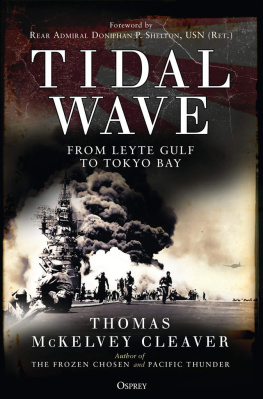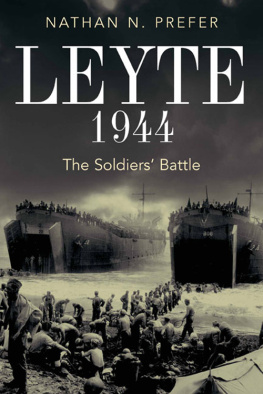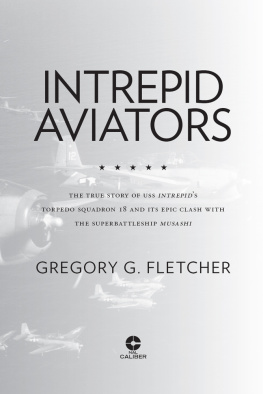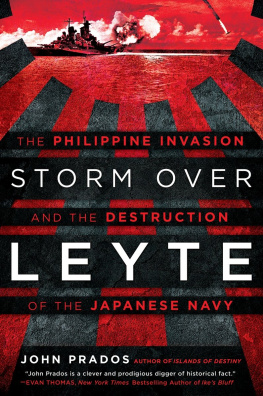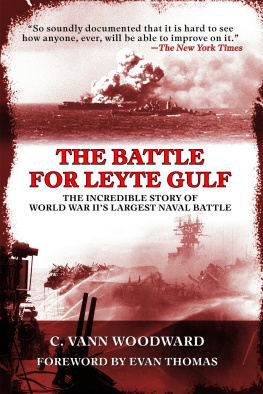This edition is published by ESCHENBURG PRESS www.pp-publishing.com
To join our mailing list for new titles or for issues with our books eschenburgpress@gmail.com
Or on Facebook
Text originally published in 1961 under the same title.
Eschenburg Press 2017, all rights reserved. No part of this publication may be reproduced, stored in a retrieval system or transmitted by any means, electrical, mechanical or otherwise without the written permission of the copyright holder.
Publishers Note
Although in most cases we have retained the Authors original spelling and grammar to authentically reproduce the work of the Author and the original intent of such material, some additional notes and clarifications have been added for the modern readers benefit.
We have also made every effort to include all maps and illustrations of the original edition the limitations of formatting do not allow of including larger maps, we will upload as many of these maps as possible.
THE BATTLE OF LEYTE GULF
Stan Smith
Special Preface by
Rear-Admiral William H. Brockman, USN (Ret.)
Official Photographs,
U.S. Navy
PREFACE
SIXTEEN YEARS AFTER THE BATTLE for Leyte Gulf, the battle still stays alive, a part of our national heritage. In the minds and hearts of the men who fought at Leyte it is sixteen hours ago or sooner. You still hear occasional references to my old bucket and that kamikaze plane, and as an author you know that the battle has its importance. Not long ago, when the Navy got ready to scrap the Enterprise , a crew of its former officers and men took places on those venerable decks, and thought for a moment about the days when the Big E was a formidable part of the United States Navy. The moment was created by those men, now civilians, who felt deep nostalgia for the link that had bound them years before, and now called them back for a last muster. These things, I think, have tangible significance. Chiefly, it means that Leyte still lives.
In this work, I have attempted to recreate most operational phases of the Battle. And yet I am certain there is much material which has not been includednot for any lack of conscientiousness on my part, but because that material was simply not available. Leyte was based on Action Reports, diaries, letters to the author, official studies and information relayed by other sources. Leyte was an all-service showthat is, all branches of the service took a vital part. Much of the action centered about the men of the Third Fleet, but there were many more thousands who gave their lives in other parts of the Pacific, who took no part in the Battle.
The Japanese fighting man, the enemy, was shrewd, resourceful, well-equipped, and brave. If he lost, it was not because of any shortcomings on his part, but because of havoc higher up. The Japanese nation, as did the United States, responded to the rigors of warfare without fear or hesitation. The enemy neither asked nor gave quarter; he fought to win, and in many cases, he fought knowing he would die.
Sixteen years later, the heat of battle is over. Yet, if you listen very carefully you can still hear all the ruffles and flourishes as they were known by men of all branches of service. Midway was far more decisive than Leyte, but because Leyte was the last great operationbecause it was the last battle in which such engagements as Oldendorfs Capping the T and the charge of the destroyers under Coward and Smoot and the Sixth Army fighting at Ocmocnobody can ever really forget.
If the author has at times seemed to be a bit partisan Navy, it was only because he happened to be a submarine sailor on war patrol, so kindly tolerate the prejudice. Perhaps it is just the esprit de corps coming out in print.
Important reference sources included: Samuel Eliot Morisons Volume XII Leyte (one book of a 15-book series by that eminent scholar and writer); C. Van Woodward, The Battle for Leyte Gulf; Action Reports of the Navy , by enlisted men and officers who figured in the Battle; Submarine by Theodore Roscoe, published by the U.S. Naval Institute; Destroyer by Roscoe; The Army Air Forces in World War II , Vol. 5, by W. F. Craven and J. L. Cate; Battle Report , Vol. 4, by Captain Walter Karig, USNR; Life , Time , The New York Times , The Manila Chronicle , and American Magazine; The Imperial Japanese Navy in World War II; Ships in Esso Fleet in World War II; James Fields Japanese at Leyte Gulf; M. Hamlin Cannons Leyte : The Return to the Philippines , in the U . S . Army in World War II series; Brig.-Gen. J. F. C. Fullers A Military History of the World , Vol. 3, Sturgis Report , U . S . Sixth Army Bulletin; Samurai , by Martin Caiden; and The Divine Wind , by Roger Pineau.
The author expresses sincere gratitude to Mr. Noah Sarlat of Stag magazine, and to Mr. Phil Hirsch of Man s Magazine for their permission to reprint excerpts from his stories which have already appeared in their magazines. My thanks to Commander Russel Bufkins, USN, of the Navys Magazine and Book Branch, for his infinite patience and skill in choosing the pictures herein that are representative likenesses of the ships and men, both Japanese and American, who figured in Leyte.
Finally, my thanks to my editor and friend, Samuel H. Post.
Stan Smith
New York City
December 20, 1960
FOREWORD
BY 1944 JAPANS HOPES of salvation were lugubriously pinned to a decisive engagement in the Philippines, a perimeter of battle away from the homeland, in which it was hoped that the enemy would be defeated. After seven weeks of unparalleled, unrestricted warfare against the U.S. Navy, and later the Army, these hopes were dashed. Japan had nowhere to go except downhill to ultimate unconditional surrender; seven hellish weeks of combat on, under, and above the sea were to prove (not that this was even necessary after Midway) the mettle of the United States Navy and the two principal fleets into which it was divided.
Among the multiplicity of assignments in which our Navy was engaged in World War II, Leyte Gulf stands out as perhaps the most difficult because it involved combat of unprecedented nature, and the lifting of the largest single amphibious operation that the world had ever knownthousands of troops, ships, and supplies to the Philippines. The entrance of the Kamikaze units, that devastating mass-suicide attempt of the Japanese Air Force, was a last desperate attempt of the enemy to stave off defeat. It is a worthy point of conjecture to speculate on the eventualities had the Kamikaze units been introduced several days or weeks before. By the same token, one may well ask what would have been the outcome had there been no Hiroshima or Nagasaki A-Bombs.
To continue this wholly conjectural thought one may ask about the outcome had Hirohito chosen to continue even after his homeland was ravaged by American bombs? Catastrophe after catastrophe would have befallen the Japanese Empire, and a ghastly toll of human life combined with fiery extinction of resources would have been the end result. That civil war did not come after the A-Bomb attests to Japans propaganda machine, its blind obedience to Emperor Hirohito, and to a great and childish faith in the man-deity who had created the seeds of havoc.





